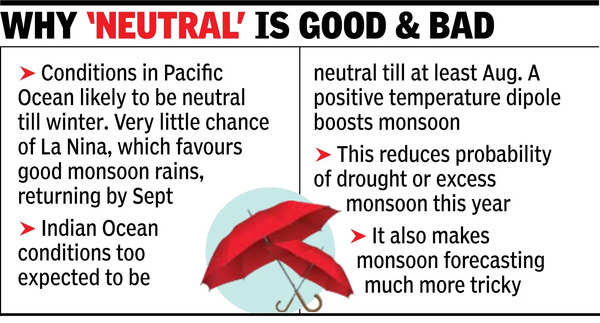La Nina over, India is unlikely to see dry or extreme rain. Bharat News

New Delhi: La Nina’s position in the Pacific Ocean, which usually favor good monsoon rains in India, was declared late Thursday night, with the world’s largest ocean to remain in a ‘neutral’ phase till winter. This can be good news for the monsoon of India, as it reduces the possibility of drought or excess rainfall in the season, but it is also likely to make the monsoon forecast difficult, the experts said.
Connecting the difficulty of forecasts, conditions in the Indian Ocean are also likely to be ‘neutral’ by at least August, according to the latest Australian weather bureau update. Along with Pacific, the surface temperature in the Indian Ocean plays a major role in the monsoon of India, with the ‘positive’ phase of the ocean – when water in the Western Indian Ocean is warm compared to those in the east – usually promotes rain.
For Prashant, the US Climate Prophecy Center stated in a release that there was more than 50% of the possibility that the neutral position would remain up to the sept. The possibility of persistence till the end of the year was also higher than that La Nina or El Nino said.

If this forecast is correct, it will be the first time in 12 years that the monsoon will not have the appearance of Perry Odd, or months before or after, El Nino or La Nina will not have the appearance. These two opposite Pacific Ocean conditions are seen as the most important among large-scale weather characteristics that determine how much rain India receives during the June-September period.
“When the position of the Pacific Ocean is neutral, all landscapes are open to the Indian monsoon. However, dried or flood probability is small. Generally, in neutral Pacific circumstances, we do not expect unwanted monsoon consequences,” Maji Van, experienced meteorologists, and the former secretary of the Union Ministry of Sciences said.
During neutral conditions in the Pacific SurfaceThe surface water temperature in the eastern and central equatorial regions of the ocean is neither unusually warm (El Nino’s position, which weakens the Indian monsoon) nor very quiet (la neena). While it is called the natural state of the ocean, the neutral year it is not common.
Rajewen said, “The monsoon is more difficult to predict in such circumstances. The forecasts have to be more careful and closely watching in factors such as the status of the Atlantic Ocean. Internal mobility can also play a role,” said Rajivan, which is also a forecast of pre -monsoon monsoon.
According to the first monsoon forecast of this year, built by private agency Skymet, the total monsoon rainfall in India is likely to be 103% of the long -term average, at the high end of the normal border.




